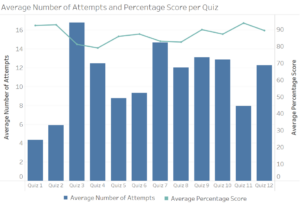Pooja Vashisth
Course/ProgramCSC258 |
Design Context
When instructors conduct anonymous feedback surveys to gauge how students are performing, they can fail to reach those who really need their support. Some students don’t realize when to ask for help or they struggle knowing exactly where and/or for what they need help.
I joined D3QA to gather assistance in my planning for early and targeted interventions to identify struggling students in the course and reach out to them, to help them in attaining better course engagement and getting back on track.
Instructional Challenge
This study aims to assist with spotting struggling students more easily mid-course or earlier. e.g., measuring course engagement and identifying specific assignments and questions that the students are struggling with.
By identifying points in the course where students could use support, I hope to assess these early warning signs to decide whether there is a need for a supplementary course material to improve comprehension and engagement.
Design Strategy
I used information on the number of views and timing of access to the reading materials was collected from the New Analytics’ Course Activity Report on the course’s Quercus page. The data were filtered by the resources and dates relative to the weekly quizzes. The scores, number of attempts, and date and time of submission of the weekly quizzes were extracted from the Quiz Reports on the course’s Quercus page. For full details view the report.
With these data, a possible intervention is to provide students with extra readings, videos and resources to improve comprehension.
Use of Data to Inform Design Iteration and Instruction
With the identification of the quizzes and questions that the students may be struggling with the most, I am able to identify key concepts related to these quizzes and review them before the term tests and final exam. This helps to identify the areas where students need help with the reading material and could be used as an indicator for me to provide more support to the students by improving readings
The overall positive and significant relationships between quizzes and exam performances suggest that the weekly quizzes could be a positive preparatory material for the exams.
These results could be shared with future classes to stimulate engagement with the weekly quizzes and the related preparatory readings.
Next Steps
Potential problems/struggles may not be always linked to a concept not well understood.
While analyzing the students’ attempt behaviour demonstrated that the format of some quiz questions was being exploited for correct answers by applying the brute force approach. This was true as reading quizzes allowed unlimited attempts with feedback.
In this regard, future questions should be developed in a format that minimizes the effect of random guessing.

